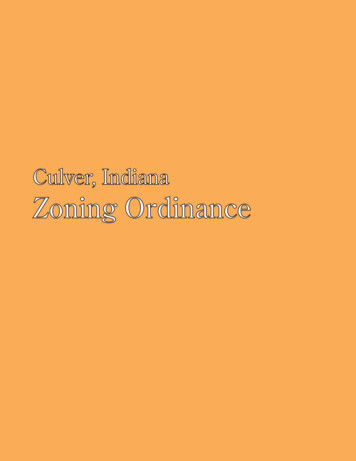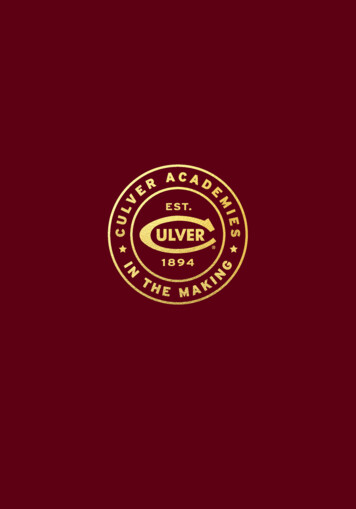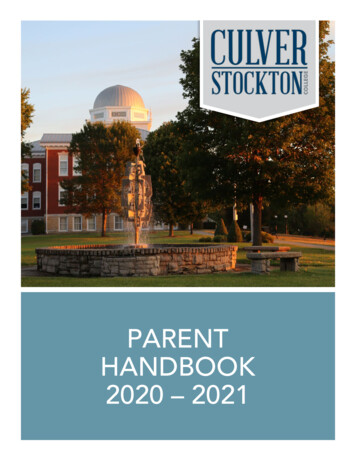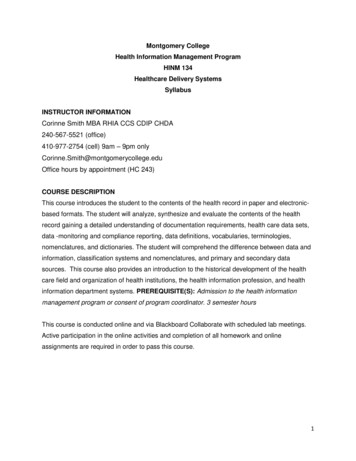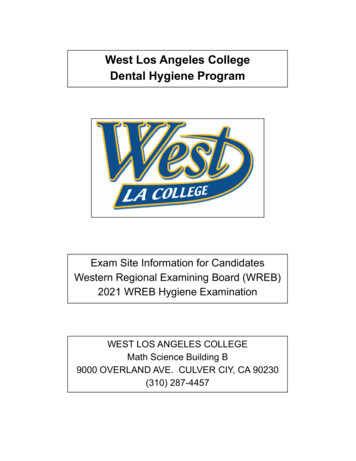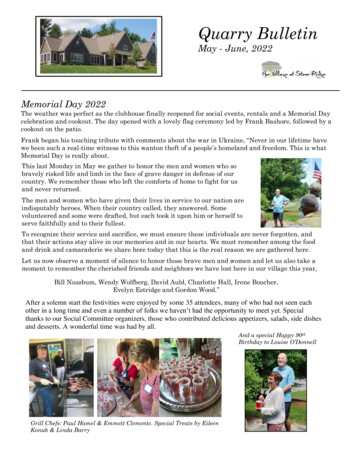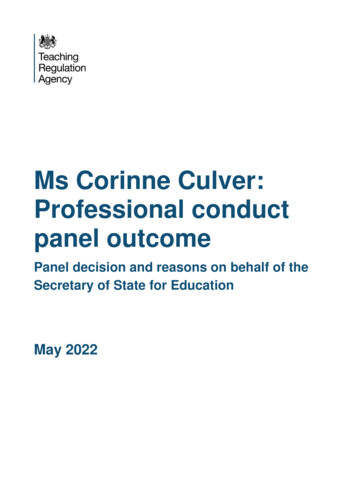
Transcription
Ms Corinne Culver:Professional conductpanel outcomePanel decision and reasons on behalf of theSecretary of State for EducationMay 2022
ContentsIntroduction3Allegations4Preliminary applications4Summary of evidence7Documents7Witnesses7Decision and reasons8Findings of fact8Panel’s recommendation to the Secretary of State17Decision and reasons on behalf of the Secretary of State202
Professional conduct panel decision and recommendations, and decision onbehalf of the Secretary of StateTeacher:Ms Corinne CulverTeacher ref number:3949262Teacher date of birth:4 June 1988TRA reference:18280Date of determination:18 May 2022Former employer:Tiger Primary School, KentIntroductionA professional conduct panel (‘the panel’) of the Teaching Regulation Agency (‘the TRA’)convened on 17 to 18 May 2022 by way of a virtual hearing via Microsoft Teams, toconsider the case of Miss Corinne Culver.The panel members were Mr Peter Ward (lay panellist – in the chair), Ms Charlotte Kelly(lay panellist) and Mr Steve Woodhouse (teacher panellist).The legal adviser to the panel was Ms Josie Beal of Birketts LLP solicitors.The presenting officer for the TRA was Ms Lucy Coulson of No5 Chambers, instructed byBrowne Jacobson LLP solicitors.Ms Culver was not present and was not represented.The hearing took place by way of a virtual hearing in public, save for parts which wereheard in private, and was recorded.3
AllegationsThe panel considered the allegations set out in the notice of proceedings dated 1 March2022.It was alleged that Ms Culver was guilty of unacceptable professional conduct and/orconduct that may bring the profession into disrepute in that, whilst employed as a teacherat Tiger Primary School between September 2017 and March 2019:1. Between November 2018 - February 2019, on one or more occasion, she usedunreasonable force and/or inappropriate physical intervention towards one ormore pupils, including by:a. Holding and/or pulling Pupil A by the hand and/or wrist so that her feet leftthe ground and/or she was on her tiptoes;b. Dragging and/or pulling Pupil A by the hand and/or wrist out of theclassroom, during which she hit her head on the door frame;c. On or around 23 January 2019, lifting and/or carrying Pupil A by placing bothher arms around her chest from behind;d. Dragging and/or pulling Pupil D by the hand and/or wrist to remove him fromthe bathroom.2. She failed to record all instances of her use of force and/or physical contact onone or more of the School’s systems.3. On one or more occasion she shouted and/or made inappropriate commentstowards and/or in the proximity of one or more pupils, including:a. ‘get her/him away from me’b. ‘I can’t do this’ and/or ‘I’ve had enough’c. Stating ‘she’s been a right brat’ or words to that effect, when referring toPupil C.Ms Culver made no specific admission of facts or of unacceptable professional conductand/or conduct that may being the profession into disrepute, however she did providewritten representations which the panel considered.Preliminary applicationsThe panel noted that since the date of the referral to the TRA in this case, new ‘Teachermisconduct: Disciplinary procedures for the teaching profession’ were published in May4
2020 (the ‘May 2020 Procedures’). The panel understands that the earlier provisionscontained within the ‘Teacher misconduct: disciplinary procedures for the teachingprofession’ updated in April 2018 (the ‘April 2018 Procedures’) apply to this case, giventhat those provisions applied when the referral was made. Although the panel has thepower to direct that the May 2020 Procedures should apply in the interests of justice orthe public interest, the panel had received no representations that this should be thecase. For the avoidance of doubt, therefore, the panel confirms that it has applied theApril 2018 Procedures in this case.Application to proceed in the absence of the teacherMs Culver was not present at the hearing nor was she represented. The presentingofficer made an application to proceed in the absence of Ms Culver.The panel accepted the legal advice provided in relation to this application and tookaccount of the various factors referred to it, as derived from the guidance set down in thecase of R v Jones [2003] 1 AC 1 (as considered and applied in subsequent cases,particularly GMC v Adeogba).The panel was satisfied that the Notice of Proceedings had been sent to Ms Culver inaccordance with the Teacher misconduct: disciplinary procedures for the teachingprofession 2018 (the “Procedures”).The panel was provided with correspondence from Ms Culver’s representative whichindicated that she did not expect to be well enough to attend the hearing and giveevidence, however she remained content for the hearing to proceed in her absence andwithout a representative present. The panel therefore concluded that Ms Culver’sabsence was voluntary and that she was aware that the matter would proceed in herabsence.The panel noted that Ms Culver had not sought an adjournment to the hearing and thepanel did not consider that an adjournment would procure her attendance at a hearing.Whilst the panel noted the comments about Ms Culver’s [REDACTED], it was notprovided with any medical evidence from a medical professional nor was it given anindication as to if or when Ms Culver might be well enough to attend a hearing. The panelwas also mindful that Ms Culver wanted the hearing to go ahead and that delaying thehearing might have an adverse impact on Ms Culver’s [REDACTED].The panel considered that it was in the public interest for the hearing to take place. It alsoconsidered the effect on the witnesses of any delay.Having decided that it was appropriate to proceed, the panel agreed to seek to ensurethat the proceedings were as fair as possible in the circumstances, bearing in mind thatMs Culver was neither present nor represented.5
Application for part of the hearing to be heard in privateThe panel considered an application from Ms Culver that part of the hearing [REDACTED] - should be heard in private.The panel heard submissions from the presenting officer and was directed to writtenrepresentations from Ms Culver and her representative before reaching its decision. Thepresenting officer did not have any objection to the application.The panel granted the application. The panel considered it was not contrary to the publicinterest for the part of the hearing, which was the subject of the application, to be heardin private.Application to admit additional documentsThe panel considered a preliminary application from the presenting officer for theadmission of additional documents.The presenting officer’s documents were a late evidence bundle comprising of emailsbetween the presenting officer and the Headteacher of Tiger Primary School and emailsbetween the teacher’s representative and the presenting officer.The documents subject to the application had not been served in accordance with therequirements of paragraph 4.20 of the Procedures. Therefore, the panel was required todecide whether the documents should be admitted under paragraph 4.25 of theProcedures.The panel heard representations from the presenting officer in respect of the application.The panel considered the additional documents were relevant. The panel noted that theteacher’s representative had been made aware of the documents and had not providedany objection. Accordingly, the documents were added to the bundle.Other preliminary issuesThe presenting officer informed the panel of an error in the anonymised pupil list on page7 of the hearing bundle. The names for Pupil D and Pupil E had been mixed up. Pupil Dwas actually [REDACTED] and Pupil E was actually [REDACTED].The presenting officer told the panel that Ms Culver’s representative had been madeaware of this error on the day of the hearing. He did not have any objection to theanonymised pupil list being amended by hand, and he informed the presenting officerthat he believed Ms Culver had understood who Pupil D was when addressing allegation1(d) in her witness statement.The panel therefore agreed to amend the anonymised pupil list.6
The panel noted an error in the notice of hearing on page 11 of the bundle. One of thepanellists, Charlotte Kelly, was incorrectly named as being Charlotte [REDACTED]. Thepresenting officer informed the panel that Ms Culver’s representative had been madeaware of this and did not raise any objections, nor any conflict of interest in respect ofCharlotte Kelly.Finally, the panel was provided with two CCTV recordings, however it was only able toview one of the recordings. The presenting officer confirmed that the second CCTVrecording was not directly relevant to the allegations before the panel and that the TRAwas content to proceed without the CCTV recording and the stills of the recordingcontained within the hearing bundle. The panel did not consider the second CCTVrecording and the stills of the recording were disregarded.Summary of evidenceDocumentsIn advance of the hearing, the panel received a bundle of documents which included: Section 1: Chronology and anonymised person list – page 6 to 7 Section 2: Notice of proceedings – pages 9 to 21 Section 3: TRA witness statements – pages 23 to 36 Section 4: TRA documents – pages 38 to 120 Section 5: Teacher documents – pages 122 to 155 CCTV footage – provided separatelyIn addition, the panel agreed to accept the following: Late evidence bundle containing emails between the presenting officer and theHeadteacher of Tiger Primary School and emails between the presenting officerand teacher’s representative.The panel members confirmed that they had read all of the documents within the bundle,in advance of the hearing and the additional documents that the panel decided to admit.WitnessesThe following witnesses were called to give oral evidence on behalf of the TRA: Staff Member 1 [REDACTED]7
Staff Member 3 [REDACTED]Decision and reasonsThe panel announced its decision and reasons as follows:The panel carefully considered the case before it and reached a decision.In summary, Ms Culver was employed by Tiger Primary School (‘the School’) from 1September 2012 until she resigned on 15 March 2019. Ms Culver commenced heremployment as a teaching assistant and was later promoted to become an unqualifiedteacher from 25 September 2017. Ms Culver taught a reception class.On 6 February 2019, a member of staff reported concerns about Ms Culver’s behaviourtowards pupils. A referral was made to the Local Authority Designated Officer (‘LADO’).On 7 February 2019, Ms Culver was suspended from duty.Interviews with staff members were held on 11 February 2019 and further interviewswere carried out on 13 February 2019.An investigation meeting with Ms Culver was held on 1 March 2019, which wasadjourned midpoint as Ms Culver felt she could not continue with the meeting.Investigation questions were therefore sent to Ms Culver by email, on the same day,which she responded to on 5 March 2019.Ms Culver resigned from her post on 15 March 2019. A disciplinary hearing was held on19 March 2019. The matter was referred to the TRA on 26 March 2019.Findings of factThe findings of fact are as follows:The panel found the following particulars of the allegations against you proved, for thesereasons:1. Between November 2018 - February 2019, on one or more occasion, youused unreasonable force and/or inappropriate physical intervention towardsone or more pupils, including by:a. Holding and/or pulling Pupil A by the hand and/or wrist so that herfeet left the ground and/or she was on her tiptoes;b. Dragging and/or pulling Pupil A by the hand and/or wrist out of theclassroom, during which she hit her head on the door frame;8
c. On or around 23 January 2019, lifting and/or carrying Pupil A byplacing both your arms around her chest from behind;d. Dragging and/or pulling Pupil D by the hand and/or wrist to removehim from the bathroom.Allegation 1(a)The panel was provided with oral and written evidence from Staff Member 3 in respect ofallegation 1(a). Staff Member 3 explained that at some point in winter 2018 she heard achild screaming in Ms Culver’s classroom and went to check if Ms Culver required anyassistance. Staff Member 3 said that when she arrived at the classroom, Ms Culver hadhold of Pupil A by the wrist and was holding her up in the air; she described the grip as“tight and forceful”. Staff Member 3 said that Pupil A’s feet were not touching the floorand estimated that the distance between Pupil A’s feet and the floor was broadlyequivalent to the length of her forearm. Staff Member 3 said that Pupil A’s feet remainedoff of the floor throughout her conversation with Ms Culver. Staff Member 3 took Pupil Ainto her classroom after this incident.Staff Member 3 described a further incident in December 2018 where Ms Culver draggedPupil A out of a classroom to the carpet in the hall and shouted at her. Staff Member 3stated that Ms Culver dragged Pupil A by her wrist and that her feet were not touchingthe floor.Staff Member 3 told the panel that staff members had received de-escalation trainingand, amongst other things, were provided with a lanyard setting out de-escalationmethods to work through during challenging situations. Staff Member 3 said that she didnot witness Ms Culver attempting de-escalation techniques during the two incidents withPupil A.The panel found Staff Member 3 to be a credible and consistent witness.The panel noted Ms Culver’s witness statement, in which she indicated that she had norecollection of having held a pupil off the ground by their wrist and had no recollection ofthe incidents described by Staff Member 3. Ms Culver stated that she might have heldboth of Pupil A’s hands on occasion.Having considered the evidence before it, the panel was satisfied on the balance ofprobabilities that on at least one occasion Ms Culver held and/or pulled Pupil A by thehand or wrist so that her feet left the ground. The panel was not presented with anyevidence to suggest that it was appropriate for Ms Culver to use force in thesecircumstances. For example, there was no evidence of danger or potential risk to thepupil or others. The panel did not consider that it was appropriate to hold a pupil off theground in this manner. The panel therefore concluded that Ms Culver used unreasonableforce and inappropriate physical intervention. The panel found allegation 1(a) proven.9
Allegation 1(b)The panel was provided with oral and written evidence from Staff Member 1 in respect ofallegation 1(b). Staff Member 1 explained that Pupil A could be difficult and defiant andwould sometimes repeatedly say “no”. [REDACTED].Staff Member 1 recalled a separate incident where she believed Pupil A was saying “no”to Ms Culver. Staff Member 1 stated that, whilst removing Pupil A from the classroom, MsCulver dragged Pupil A by her wrist causing Pupil A to be on her tip toes. Staff Member 1believed that Ms Culver was dragging Pupil A in a forceful manner. Staff Member 1 hearda scream, and later discovered that Pupil A had banged her head on the door framewhilst she was being removed from the classroom by Ms Culver. Staff Member 1confirmed that she did not see Pupil A bang her head on the door frame and was unsurehow this happened.The panel found Staff Member 1 to be a credible and consistent witness.In her witness statement, Ms Culver recalled the incident referred to in allegation 1(b),but not how it started. Ms Culver stated that she had no recollection of dragging Pupil Aby the wrist so that she was on her tiptoes. Ms Culver submitted that she was shocked bythe description and did not recall being angry. Ms Culver did, however, recall that Pupil Abumped her head on the doorframe. Her recollection was that Pupil A pulled back fromMs Culver whilst walking through the door and banged her head on the doorframe.The panel was provided with a school incident form which stated that Pupil A had walkedinto a door frame and needed a cold compress. The panel was also provided with arecord Ms Culver added to the School’s safeguarding system, My Concern. The recordstated: “[Pupil A] has had moments of defiance today where she would shout at adultsand refuse instructions. She has needed a lot of 1-1 time today [Pupil A] also had a bumpat school today – she walked into the door frame of [the classroom] causing a red markon her right ear ”.Having considered the evidence before it, the panel was satisfied on the balance ofprobabilities that Ms Culver dragged or pulled Pupil A by the hand or wrist out of theclassroom. The panel was also satisfied that Pupil A sustained an injury to her headwhilst being dragged out of the classroom. However, the panel did not have sufficientevidence before it to conclude how Pupil A injured her head or whether the injury wascaused by Ms Culver, nor did the panel consider that the allegation required it to makesuch a determination.The panel was not presented with any evidence to suggest that it was appropriate for MsCulver to use force in these circumstances. For example, there was no evidence ofdanger or potential risk to the pupil or others. The panel considered that Ms Culver couldand should have attempted to use non-physical de-escalation techniques. The panel10
therefore concluded that Ms Culver used unreasonable force and inappropriate physicalintervention. The panel found allegation 1(b) proven.Allegation 1(c)In her witness statement, Ms Culver stated that she remembered finding Pupil A swingingon the bannister of the stairs near to the classroom. She was concerned about this andtried to take Pupil A’s hand. Pupil A pulled away, which stretched their contact and,because Ms Culver was concerned that Pupil A might fall and injure herself, Ms Culverkept hold of her. Ms Culver accepted that she extended Pupil A’s arm and that she thenpicked Pupil A up to take her back to the classroom.Ms Culver stated that she had not been trained in physical restraint techniques such asteam teach and apologised that she picked up Pupil A clumsily or inappropriately. Shestated that she understood that physical force should be a last resort and that she shouldhave been more patient with Pupil A, but she had been influenced by the difficulties thatPupil A had presented throughout the year.The panel was shown CCTV footage relating to allegation 1(c). In the footage, Pupil Acan be seen swinging on the bannister to the stairs. Ms Culver can be seen pulling PupilA by the arm, and lifting/carrying Pupil A by placing both arms around her chest frombehind. The panel was therefore satisfied that the events described in allegation 1(c)occurred.Whilst the panel appreciated that Ms Culver might have been concerned about Pupil Aplaying on the stairs, the CCTV footage did not show Ms Culver attempting to use anyother techniques to de-escalate the situation or guide Pupil A away from the stairswithout using force.The panel was provided with Ms Culver’s training certificates for care and control ofchildren and young people training (undertaken in 2012 and valid for 12 months) andpaediatric first aid (undertaken in 2015, and valid until July 2018). The panel noted MsCulver’s comments that she had not received training in respect of physical restrainttechniques and it was mindful that the training she had attended in respect of othermatters appeared to have been before she became an unqualified teacher and a numberof years before the incident described in allegation 1(c). Staff Member 3 told the panelthat team teach training was provided to the headteacher and key stage leaders and thatthe training was passed on at a compulsory after School session. However thedisciplinary meeting notes indicated that Ms Culver had not attended team teach trainingdue to [REDACTED].The panel was not able to clearly determine what training Ms Culver had received inrespect of physical intervention. However, the panel considered that, Ms Culver’s actionswere contrary to the School’s Positive Handling and Physical Intervention Policy which11
stated that physical intervention should be used as a last resort and that the level ofrestraint employed should be the minimum necessary. It also stated that staff should bemindful of the levels of risk associated with extending or flexing joints and pressure onthe neck, chest or abdomen.The panel considered that force should be used as a last resort, as acknowledged by MsCulver in her witness statement. The panel was of the view that Ms Culver’s actionsconstituted a substantial and inappropriate physical intervention as a first resort. Thepanel therefore concluded that Ms Culver used unreasonable force and inappropriatephysical intervention. The panel found allegation 1(c) proven.Allegation 1(d)The panel was provided with oral and written evidence from Staff Member 1 in respect ofallegation 1(d).Staff Member 1 explained that Pupil D was often reluctant to come to school and, whendropped off at school, he would often go to the bathroom and scream and shout.Staff Member 1 recalled an incident where Pupil D was screaming in the bathroom andMs Culver took him by the wrist and dragged him out of the bathroom. Staff Member 1described the dragging as “rough” and stated that Pupil D was screaming during theincident, although she believed that this was because he was in a temper rather thanbecause Ms Culver was hurting him.Staff Member 1 told the panel that she could hear Pupil D banging on the door in thebathroom and making a lot of noise. She could not see inside the bathroom but she couldsee Pupil D being dragged from the bathroom.As referred to above, the panel found Staff Member 1 to be a credible and consistentwitness.In her witness statement, Ms Culver stated that she knew which pupil was beingdescribed in this allegation. She submitted that at times, Pupil D would hide in thebathroom and would have to be led out, but it would always be done gently by the hand.Ms Culver did not recall this incident and was shocked and upset by the description.Having considered the evidence before it, the panel was satisfied on the balance ofprobabilities that Ms Culver dragged or pulled Pupil D by the hand or wrist to remove himfrom the bathroom.The panel was not presented with any evidence to suggest that it was appropriate for MsCulver to use force in these circumstances. For example, there was no evidence ofdanger or potential risk to the pupil or others. The panel was of the view that there wasno reason for Pupil D to be dragged, or even removed, from the bathroom. The panel12
considered that Ms Culver could and should have attempted to use non-physical deescalation techniques. The panel therefore concluded that Ms Culver used unreasonableforce and inappropriate physical intervention. The panel found allegation 1(d) proven.On examination of the evidence before the panel, the panel was satisfied that the facts ofallegations 1(a), (b), (c) and (d) were proven.2. You failed to record all instances of your use of force and/or physicalcontact on one or more of the School’s systems.In her witness statement, Ms Culver submitted that she understood her duty to reportanything untoward, and took this seriously. She believed she would have reportedappropriately had she thought an incident of force or physical contact had occurred. MsCulver stated that she did report Pupil A bumping her head and treated the injury in theappropriate way.In respect of the CCTV footage concerning the incident with Pupil A on or around 23January 2019, Ms Culver accepted that, upon reviewing the footage, it would have beenappropriate to record that handling and apologised for the oversight in not doing so.As set out above, the panel was provided with a school incident report form which statedthat Pupil A had walked into a doorframe and needed a cold compress. It was unclearwhether this form was completed by Ms Culver.The panel was also provided with two records made by Ms Culver on the School’ssafeguarding system, My Concern, both of which related to Pupil A. The first entry, on 24January 2019, referred to Pupil A refusing instructions and shouting, resulting in MsCulver taking her out of the classroom to spend some time in a “buddy” class. Thesecond entry, on 4 February 2019, is referred to above and stated: “[Pupil A] has hadmoments of defiance today where she would shout at adults and refuse instructions. Shehas needed a lot of 1-1 time today [Pupil A] also had a bump at school today – shewalked into the door frame of [the classroom] causing a red mark on her right ear ”.The panel was concerned that the My Concern reports made by Ms Culver did notaccurately record the incidents that had taken place. For example, Ms Culver did notrecord that Pupil A had bumped her head whilst Ms Culver was removing her from theclassroom using force.The panel was not provided with any evidence to suggest that Ms Culver had recordedher use of force and/or physical contact as described in allegations 1(a) to 1(d) above.The panel therefore concluded that Ms Culver failed to record the instances of her use offorce and/or physical contact as described in allegations 1(a) to 1(d) above.On examination of the evidence before the panel, the panel was satisfied that the facts ofallegation 2 were proven.13
3. On one or more occasion you shouted and/or made inappropriatecomments towards and/or in the proximity of one or more pupils, including:a. ‘get her/him away from me’b. ‘I can’t do this’ and/or ‘I’ve had enough’c. Stating ‘she’s been a right brat’ or words to that effect, when referringto Pupil C.The panel was provided with oral and written evidence from Staff Member 1 in respect ofallegations 3(a) and 3(b). Staff Member 1 recalled a number of occasions where MsCulver would shout in the presence of pupils. Staff Member 1 believed the shouting wasloud and often in an angry voice. Staff Member 1 stated that Ms Culver would often say(in front of pupils) “get her/him away from me”, normally about Pupil D, and that shewould also say (again in front of pupils) “I can’t do this I’ve had enough”.The panel also considered the witness statement and oral evidence of Staff Member 3 inrespect of allegation 3(c). Staff Member 3 stated that, in November or December 2018,she went into Ms Culver’s classroom and asked her how she was. Ms Culver appearedfrustrated and said, whilst nodding towards Pupil C, “she has been a right brat”. StaffMember 3 said that, when Ms Culver said this, Pupil C was sat on the carpet directly infront of her. Staff Member 3 said that Ms Culver was using a normal voice and that PupilC looked up at the time and could, therefore, have heard what Ms Culver said.In her witness statement, Ms Culver accepted that she may have said “get her/him awayfrom me” when she was stressed or frustrated, but would have not intended a pupil tohear it. Ms Culver also accepted that she said “I can’t do this” and “I’ve had enough” in2018/2019. She said that she felt completely exhausted and was asking for help as anunqualified teacher in charge of a class of 31 pupils, a number of whom had additionallearning and behavioural needs.Ms Culver also accepted that she probably said “she has been a right brat” in front ofPupil C. She stated that stress and a lack of training in respect of how to manage such achallenging classroom meant that she sometimes spoke out. Whilst she tried not to showthis level of distress in front of pupils, she accepted that, at times, she could have beenoverheard, which was not her intention. Ms Culver accepted that this was inappropriateand apologised for it.Having considered the evidence before it, the panel concluded that it was more likelythan not that Ms Culver had made all of the comments set out at allegations 3(a) to 3(c)in front of pupils.The panel concluded that all of the comments set out at allegations 3(a) to 3(c) wereinappropriate comments. Ms Culver was in a position of trust, particularly as a reception14
teacher responsible for teaching pupils in their formative years. She was a role modelresponsible for developing confidence, self-esteem and shaping the minds of four andfive year old pupils. The panel was of the view that pupils who overhead Ms Culver’scomments might feel that they had done something wrong or were not wanted in herclassroom. It was not appropriate for Ms Culver to say “get him/her away from me” inrespect of a pupil or call a pupil a “brat”. Whilst the panel appreciated that Ms Culver mayhave been under stress, it was not appropriate for her to say “I can’t do this” or “I’ve hadenough” in front of pupils.On examination of the evidence before the panel, the panel was satisfied that the facts ofallegation 3(a), (b) and (c) were proven.Findings as to unacceptable professional conduct and/or conduct thatmay bring the profession into disreputeHaving found the allegations proved, the panel went on to consider whether the facts ofthose proved allegations amounted to unacceptable professional conduct and/or conductthat may bring the profession into disreputeIn doing so, the panel had regard to the document Teacher Misconduct: The Prohibitionof Teachers (February 2022), which is referred to as ‘the Advice’.The panel was satisfied that the conduct of Ms Culver in relation to the facts foundproved, involved breaches of the Teachers’ Standards. The panel considered that, byreference to Part 2, Ms Culver was in breach of the following standards: Teachers uphold public trust in the profession and maintain high standards ofethics and behaviour, within and outside school, byo treating pupils with dignity, building relationships rooted in mutual respect,and at all times observing proper boundaries appropriate to a teacher’sprofessional positiono having regard for the need to safeguard pupils’ well-being, in accordancewith statutory provisionso showing tolerance of and respect for the rights of others Teachers must have proper and professional regard f
Ms Culver was not present at the hearing nor was she represented. The presenting officer made an application to proceed in the absence of Ms Culver. The panel accepted the legal advice provided in relation to this application and took account of the various factors referred to it, as derived from the guidance set down in the .

